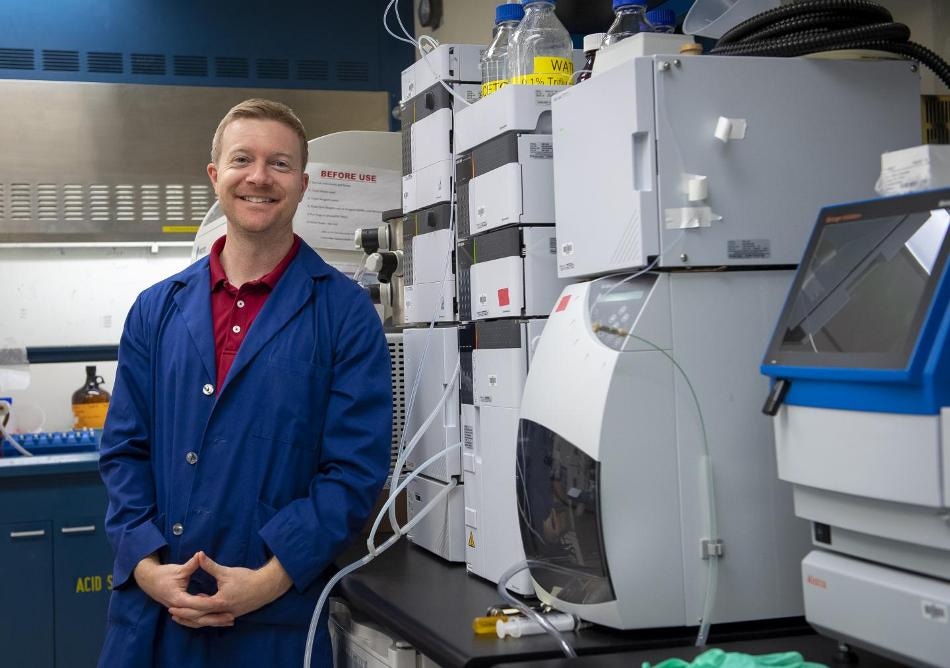May 2 2019
In an attempt to improve Soldier lethality, Army scientists are designing biorecognition receptors that can offer stable performance in multi-domain settings with the ability to gather real-time assessments of Soldier health and performance.
 Dr. Matt Coppock, chemist and team lead at ARL, stands in his research laboratory at ARL headquarters in Adelphi, Maryland, where he is developing biorecognition receptors capable of consistent performance in multi-domain environments with the ability to collect real-time assessments of Soldier health and performance. (Image credit: U.S. Army Photo by Jhi Scott)
Dr. Matt Coppock, chemist and team lead at ARL, stands in his research laboratory at ARL headquarters in Adelphi, Maryland, where he is developing biorecognition receptors capable of consistent performance in multi-domain environments with the ability to collect real-time assessments of Soldier health and performance. (Image credit: U.S. Army Photo by Jhi Scott)
"The Army will need to be more adaptive, more expeditionary and have a near-zero logistic demand while optimizing individual to squad execution in multifaceted operational environments," said Dr. Matt Coppock, chemist and team lead for the U.S. Army Combat Capabilities Development Command's Army Research Laboratory, the Army's corporate research laboratory known as ARL. "It can be envisioned that real-time health and performance monitoring, as well as sensing current and emerging environmental threats, could be a key set of tools to make this possible."
ARL researchers, in partnership with scientists from the California Institute of Technology and Indi Molecular, Inc., created a protein catalyzed capture (PCC), agent technology that enhances earlier versions of receptors and could allow the monitoring of environmental and personal data of Soldiers in the field. The study, sponsored by the Army's Institute of Collaborative Biotechnologies since 2012, is presented in a detailed review article for Chemical Reviews.
PCC technology has demonstrated improvements in receptor stability, adaptability, and manufacturability over standard antibody receptors, and supports the Soldier Lethality Cross-Functional Team as a potentially viable technology to monitor Soldier performance via relevant biomarkers collectable from wearable sensors.
Dr. Matt Coppock, Chemist and Team Lead, U.S. Army Combat Capabilities Development Command's Army Research Laboratory.
Biological receptors are combined into a biosensor to selectively trap a target of interest from a complex mixture such as sweat, blood, salvia, and so on, to create the measurable effect by the sensor, he said.
"Without the receptor, it would be impossible to know you are detecting what you want to detect," Coppock said.
Antibodies taken from animals injected with the target of interest are applied as receptors in biological sensors because of their selectivity for the target and high binding strengths.
"The gold standard receptor work is based around antibodies, which are fantastic at target capture and selectivity, but their detection capabilities are somewhat limited due to their instability, limited shelf life, and batch-to-batch performance variation," Coppock said.
The team formulated a different and more innovative approach.
"As an alternative, peptide-based receptors are smaller, simpler to produce, inexpensive and much more robust to environmental stresses, while still retaining the desirable binding properties of an antibody," Coppock said.
Receptors used by the researchers can retain almost all activity after being heated for one hour at 90 °C, while a number of antibodies are fully inactive within minutes after heating to more than 70 °C.
"We utilize an entirely synthetic approach to receptor development, which allows for much more control over the incorporation of unique building blocks to guarantee stability and permit straightforward modifications for sensor integration," Coppock said.
The researchers constructed a full infrastructure of capabilities that enables them to completely develop the synthetic, peptide-based receptors at the laboratory, on-demand, and in whatever quantities necessary through extensively available peptide synthesizers.
"All aspects of the technology have progressed throughout the collaboration culminating in a high-throughput development methodology," Coppock said. "These aspects included rethinking targeting strategies, upgrading library constructs, automating screening steps and simultaneously characterizing the performance of up to 100 different peptide sequences."
The team presently can fully develop a receptor from start to finish within two to three weeks once the target of interest is identified, he explained. Earlier, this process took about five to six months.
Current Army programs are on-going to determine important biological markers correlating to Soldier health and performance, so establishing the capability for rapid development of receptors will allow the lab to keep up with and advance the biomarker discovery and analysis.
Dr. Matt Coppock, Chemist and Team Lead, U.S. Army Combat Capabilities Development Command's Army Research Laboratory.
The researchers observed that research continues on developing the design and selection process of new reagents in a faster manner to make these sensors easier to build on demand. Furthermore, ARL is presently coordinating efforts to look into sensing requirements in human performance and water and food safety.
Other probable applications of these receptors include health diagnostics, environmental biothreat surveillance, and therapeutics, which could considerably influence the warfighter.
This technology has garnered a lot of interest across the Army science and technology community, such as fellow scientists at CCDC Chemical Biological Center, CCDC Soldier Center, and the Army Medical Command.
Earlier, this cooperative research has developed biological receptors from Technology Readiness Level, or TRL-2, to TRL-4, including the effective integration into a number of assay platforms for ruggedized biological sensing in critical environments and reagent transition to the CCDC CBC.